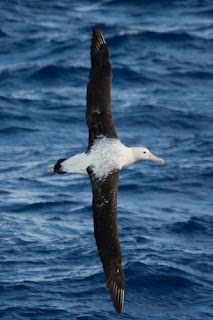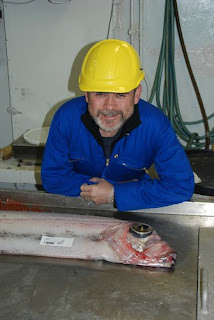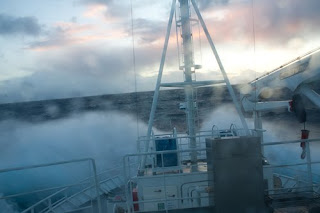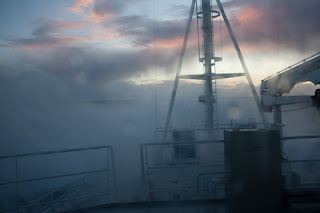An Epic Night of Fishing - Foul Weather - Seamount No 2
22 Nov 2009 Philipp Tweet this! The acoustic survey and daytime trawling at our first seamount station were followed by a 24-hour CTD Yoyo. (As the name implies, 24 hours of sending the CTD up and down and up and down, which in the end should enable Jane, our oceanographer on board, to get a picture of the temporal variations of current flow over the summit plateau.)Wandering Albatros - Diomedea exulans
Most of the scientific team spent the Yoyo-Day relaxing, tidying up things and watching an impressive array of seabirds circling the ship. (There were no less than 4 species of albatros: wandering, shy, yellow-nosed and royal albatros, as well as several species of petrel). Kirsty, however, was busy preparing a bundle of mango wood and whale bones. Not your usual way to spend a day of, but one with a very interesting scientific motivation. Kirsty is interested in whale-fall communities, small ecosystems that develop whenever large amounts of organic material (i.e. dead whale = a lot of food) hit the deep-sea bottom. In the evening these "food-packages" were sunk to the summit plateau of our seamount, and we are hoping that they will be colonized by a number of invertebrates when we come back in two years time to pick them up with a remotely operated submersible.
Then came an epic night of trawling. Within 12 hours we managed to deploy 9 nets, that is 6 plankton hauls and 3 fish trawls and boy were we busy to sort the catch. Time and again the nets brought up weird and wonderful things form the deep. The big star this time was a 2 meter long Dealfish (Trachipterus sp.) with eyes the size of a saucer!
Alex and the Dealfish
Later that day we finished the work on our first seamount with a transect of CTDs and some more plankton nets, and during that time the bad weather caught up with us. Force 7-8 winds made the transit to our next seamount a rather unpleasant one and ended up costing us more than 8 hours as the shipp was batteling an impressive swell and a CTD drop as conditions were to rough to deploy any sampling gear. Fortunately enough the wind calmed down after about 48 hours, just as we were approaching Sapmer Bank, our second seamount station.



